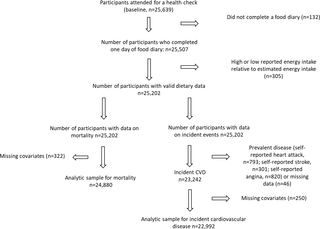PLOS Medicine ( IF 10.5 ) Pub Date : 2018-01-04 , DOI: 10.1371/journal.pmed.1002484 Oliver T Mytton 1 , Nita G Forouhi 1 , Peter Scarborough 2 , Marleen Lentjes 3 , Robert Luben 3 , Mike Rayner 2 , Kay Tee Khaw 3 , Nicholas J Wareham 1 , Pablo Monsivais 1, 4

|
Background
In the United Kingdom, the Food Standards Agency-Ofcom nutrient profiling model (FSA-Ofcom model) is used to define less-healthy foods that cannot be advertised to children. However, there has been limited investigation of whether less-healthy foods defined by this model are associated with prospective health outcomes. The objective of this study was to test whether consumption of less-healthy food as defined by the FSA-Ofcom model is associated with cardiovascular disease (CVD).
Methods and findings
We used data from the European Prospective Investigation of Cancer (EPIC)-Norfolk cohort study in adults (n = 25,639) aged 40–79 years who completed a 7-day diet diary between 1993 and 1997. Incident CVD (primary outcome), cardiovascular mortality, and all-cause mortality (secondary outcomes) were identified using record linkage to hospital admissions data and death certificates up to 31 March 2015. Each food and beverage item reported was coded and given a continuous score, using the FSA-Ofcom model, based on the consumption of energy; saturated fat; total sugar; sodium; nonsoluble fibre; protein; and fruits, vegetables, and nuts. Items were classified as less-healthy using Ofcom regulation thresholds. We used Cox proportional hazards regression to test for an association between consumption of less-healthy food and incident CVD. Sensitivity analyses explored whether the results differed based on the definition of the exposure. Analyses were adjusted for age, sex, behavioural risk factors, clinical risk factors, and socioeconomic status. Participants were followed up for a mean of 16.4 years. During follow-up, there were 4,965 incident cases of CVD (1,524 fatal within 30 days). In the unadjusted analyses, we observed an association between consumption of less-healthy food and incident CVD (test for linear trend over quintile groups, p < 0.01). After adjustment for covariates (sociodemographic, behavioural, and indices of cardiovascular risk), we found no association between consumption of less-healthy food and incident CVD (p = 0.84) or cardiovascular mortality (p = 0.90), but there was an association between consumption of less-healthy food and all-cause mortality (test for linear trend, p = 0.006; quintile group 5, highest consumption of less-healthy food, versus quintile group 1, HR = 1.11, 95% CI 1.02–1.20). Sensitivity analyses produced similar results. The study is observational and relies on self-report of dietary consumption. Despite adjustment for known and reported confounders, residual confounding is possible.
Conclusions
After adjustment for potential confounding factors, no significant association between consumption of less-healthy food (as classified by the FSA-Ofcom model) and CVD was observed in this study. This suggests, in the UK setting, that the FSA-Ofcom model is not consistently discriminating among foods with respect to their association with CVD. More studies are needed to understand better the relationship between consumption of less-healthy food, defined by the FSA-Ofcom model, and indices of health.
中文翻译:

英国营养状况模型定义的不健康食品摄入与心血管疾病之间的关联:一项基于人群的队列研究
背景
在英国,食品标准局-Ofcom 营养分析模型(FSA-Ofcom 模型)用于定义不能向儿童宣传的不太健康的食品。然而,对该模型定义的不太健康的食物是否与预期的健康结果相关的调查有限。本研究的目的是测试 FSA-Ofcom 模型定义的不健康食品的消费是否与心血管疾病 (CVD) 相关。
方法和发现
我们使用了来自欧洲癌症前瞻性调查 (EPIC)-诺福克成人队列研究的数据 ( n= 25,639) 40-79 岁的人,他们在 1993 年至 1997 年间完成了 7 天的饮食日记。使用与入院数据和截至 2015 年 3 月 31 日的死亡证明。报告的每个食品和饮料项目都使用 FSA-Ofcom 模型根据能源消耗进行编码并给出连续评分;饱和脂肪; 总糖;钠; 不溶性纤维;蛋白质; 和水果、蔬菜和坚果。使用 Ofcom 监管阈值将物品归类为不太健康。我们使用 Cox 比例风险回归来检验食用不太健康的食物与 CVD 之间的关联。敏感性分析探讨了结果是否因暴露的定义而异。分析针对年龄、性别、行为风险因素、临床风险因素和社会经济地位进行了调整。参与者平均随访 16.4 年。在随访期间,有 4,965 例 CVD 事件(30 天内死亡 1,524 例)。在未经调整的分析中,我们观察到食用不太健康的食物与心血管疾病事件之间存在关联(测试五分之一组的线性趋势,p < 0.01)。在调整协变量(社会人口学、行为学和心血管风险指数)后,我们发现食用不太健康的食物与心血管疾病(p = 0.84)或心血管死亡率(p = 0.90)之间没有关联,但两者之间存在关联。不健康食品的摄入量和全因死亡率(线性趋势检验,p = 0.006;五分之一组,不健康食品的摄入量最高,与五分之一组相比,HR = 1.11,95% CI 1.02-1.20)。敏感性分析产生了类似的结果。该研究是观察性的,依赖于饮食消费的自我报告。尽管对已知和报告的混杂因素进行了调整,但仍有可能存在残留混杂因素。
结论
在对潜在的混杂因素进行调整后,在本研究中未观察到食用不太健康的食物(按 FSA-Ofcom 模型分类)与 CVD 之间存在显着关联。这表明,在英国,FSA-Ofcom 模型在食品与 CVD 的关联方面并没有始终如一地区分食品。需要更多的研究来更好地了解由 FSA-Ofcom 模型定义的不太健康食品的消费与健康指数之间的关系。











































 京公网安备 11010802027423号
京公网安备 11010802027423号